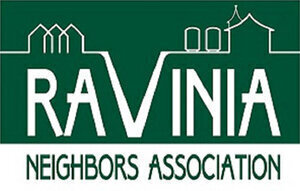History of Ravinia School, Part 2: The First School House, 1897-1913
By Elliott Miller
By the 1890s, South School was judged inadequate to handle the student population in the area. Children from 25 families in the western part of the district were being sent to school in Deerfield, and some children in the southern portion of the district attended school in Glencoe.
Special elections were held at South School. All eligible (i.e., male) voters were notified to be on hand and vote for the new schoolhouse. The ballots were slips of paper on which was printed FOR or AGAINST in large type at the top of the ballot. Voters chose a ballot and inserted it into the ballot box.
Once the construction of a new school house was approved, there was much debate over where the school should be located ̶ at the current site on Green Bay and Roger Williams, favored by residents in the western part of the district, or at a location further east in Ravinia. Two ballot attempts failed to win approval to build a new schoolhouse at the old location. On April 22, 1896 it was determined by a margin of one vote out of a total of 57 votes cast, to purchase the land on the corner of Dean Avenue in Ravinia for the new school. Locating the school further east contributed to the eventual splitting of School District 5 into eastern and western sections. (West Ridge School was built in 1899)
It then took three tries to pass the proposition to fund the new school. On May 1, 1897 the third ballot held at the South School house to build a new school house in Ravinia. The proposition was approved 56 for and 42 against, authorizing the Board of Directors to build a school house on the said site to cost not to exceed $2700.
At all these proceedings held relative to the building a school at Ravinia, George Hessler was president and H.G. Dickson was clerk.
The Chicago architectural firm of Brainerd & Holsman was hired to submit architectural plans for the new school. The initial tradesmen’s contracts were awarded in June of 1897 as follows:
Brainerd & Holsman, architects: $50
William J. Obee, masonry: $450
Zimmer & Morton, carpentry: $975
Gauntt & Robertson, painting and glazing: $142
McKenzie & Dagget, well drilling: $200
The building was 35 feet by 50 feet and consisted of two rooms, a larger classroom and a smaller store room. The school boasted “a furnace that will not only heat but also ventilate it.” The exterior was made of common, beige-colored brick (the first brick school built in the district), not the red brick of today’s Ravinia School buildings. The large room contained 48 desks and plenty of floor space and blackboard room; desks all face north, abundantly lighted, and a smaller room. There is a large entrance hall and two cloak and hat rooms. The interior was “finished in yellow southern pine and well done too.” The floors and woodwork of the school had a natural finish, which was periodically oiled instead of painted.
The first Ravinia School was opened in September 1897 with the usual programs of the time—congratulatory speeches, recitations by little girls, etc. The Highland Park News congratulated Ravinia on ”so good, complete, and up-to-date, well-built, admiralty finished and furnished a school house.” The fact that the school house was built and furnished with less that the appropriated funds suggested to the author that those involved would make good city aldermen. [i] However, it didn’t take long before the “complete and up-to-date” school house was deemed obsolete, and a new wing was built in 1913.
Maintaining the Schools
The School Board prescribed rules for students, teachers, and even the janitors. The board, wanting to protect their new school investment, met on August 26, 1899 and thoroughly considered the issue of dusting: “It shall be the duty of the janitors to see that their buildings are properly heated and dusted before 8:30 A.M. In dusting they will use a cloth or other material which will effectively remove the dust from furniture and woodwork, not merely scattering the dust broadcast in the room.”
Additional instructions were given the following year to have the janitors “wash windows and floors every two weeks and sweep and dust every day.” Janitors were lowest paid staff in the district. The Janitor of that time, Carl Bonn, was paid $10 per month.
In the early days, school janitors were not paid well, nor were they held in much esteem. In 1909, Mr. William L. McKenzie was hired to clean Ravinia School for $20 per month. Mr. McKenzie was held the job until 1912 when, upon asking for a raise to $30 per month, the board voted to look for another janitor who would work for $20 per month.
A telephone was not installed in the school until 1914. At that time, the Chicago Telephone Co. was approached to install telephones in Lincoln and Ravinia Schools.
The School Board was often frugal in allocating funds for equipment purchases. When a typewriter was requested for Ravinia School in 1927, the School Board authorized the purchase of a rebuilt one, at a cost not to exceed $50. The purchase of a piano was treated in the same way.
[i] “The Ravinia Dedication” Highland Park News, September 17, 1897, p. 1
